From Hedge Funds Review,
(from page 12 of a 23 page
PDF):
The carbon market is proving a complex beast for many to grasp, and more complex still to make profits from. Thomas della Casa from Man Group takes a comprehensive look at the market as it is, and how it may be in the future...
This report is intended to help investors understand the international carbon market.1
We focus on new developments in the carbon and power markets as well as longer term opportunities and scenarios to combat climate change. We also explain how hedge funds operate in the carbon space.
The carbon market was born out of the Kyoto Protocol which aims to place a cost on carbon emissions, a value on emissions reductions and to enable trade of the resulting allowances or credits. In response to Kyoto, the European Union (EU) committed to reduce greenhouse gas (GHG) emissions to 8% below 1990 levels by 2012.
The primary GHG is carbon dioxide or CO2. To meet this target at the lowest economic cost, the EU developed an Emission Trading Scheme (EU ETS).
The EU ETS is a cap-and-trade scheme that currently covers about 12,000 industrial plants across all 27 member states. Each country is given a fixed number of allowances for free. One allowance (EUA) represents the right to emit the equivalent of one tonne of CO2. Each country then distributes its allowances to the installations covered by the scheme. Currently, the EU ETS covers CO2 emissions from large, stationary installations in the following sectors: fossil-fuel power generation, ferrous metal producers, mineral processors, pulp and paper, and refineries.
It is likely that other sectors, such as transportation, will be included in the future.
The EU ETS is being implemented in two phases. Phase I (2005–2007) is something of a test model to establish the system. Phase II runs from 2008–2012, with total emissions caps tightening every year to achieve the Kyoto target. The greatest emphasis has been placed on thermal power generation, which currently accounts for almost 66% of all allowances in the system and more than 80% of total transactions.
For the purpose of this review, we will focus on this sector.
In addition to domestic GHG abatements, there are also ‘flexibility mechanisms’ that allow the import of carbon credits into the EU ETS. In theory, these mechanisms should allow the abatement of emissions in developing countries at minimal cost.
A whole industry based around carbon projects has emerged as it is cheaper and quicker to pick the ‘low hanging fruit’ before making expensive investments in new technology.
Such projects include methane capturing or HFC23 reduction. Both are very potent greenhouse gases. While compliance buyers (large emitters) make up a significant portion of the trading volume in the carbon market, financial players are becoming increasingly active. This includes commodity trading groups in investment banks, hedge funds, private equity firms and venture capitalists. The European carbon market was heavily criticised when prices collapsed in April/May 2006 after it became clear that far too many allowances had been handed out in phase I (2005–2007).
Despite this failure, the market has moved on and traders have begun to focus on the next phase (2008–2012). Chart 1 (upper left) shows the prices of EU allowances for phase I and II. The EUA price is, as in any market, set by supply and demand. Supply is determined by allocated allowances, some reserves for new entrants and issued carbon credits.
Demand drivers include the ETS participant’s actual emissions through the year, which in the short-term is driven by the weather and fuel prices. For example, many European power producers can utilise coal or gas, so when the price of coal falls relative to cleaner gas GHG emissions will rise.
In the longer term, political factors and the scarcity of permits will determine the price.Lobbying from the utility sector, for example, led to an over-generous allocation for phase I and the lack of scarcity led to the price crash. Most experts expect a much tighter regime starting next year during phase II.
In financial terms, the EU ETS volumes on exchanges and through brokers totalled x14.6bn last year. This is about three times more than the exchanged and brokered value from the previous year. Chart 2 (lower left), shows the volumes and financial values of CO2. What is the impact of carbon prices on power markets?
It is evident that European power producers gradually began to price in the full cost of carbon over the course of 2005. Going forward, CO2 prices are expected to be fully priced in. To generators, CO2 represents an opportunity cost, as they can ‘burn’ or sell their allocations.
Theoretically,
generators will only produce electricity if the revenue from selling electricity exceeds the revenue that they could earn from selling their fuel and EUAs. Hence, it makes economic sense to fully incorporate the new ‘cost’.
However,
the cost in phase I did not involve any cash outlay since the allowances were given out for free. This has created a debate about windfall profits as generators benefited from the carbon pass through with little to no abatement efforts. Since most utilities operate vertically integrated in an oligopolistic market environment, they face little margin pressure. This has caused much controversy, particularly in Germany, where around 70% of installed thermal capacity is coal-fired, and a number of new plants are guaranteed free certificates for many years due to successful lobbying.
The solution to this lies in the auctioning of permits, which is designated in phase II, but only up to 10% of the total. While some countries are set to auction a proportion of their allowances, the overall level of auctioning will remain modest.
The problem with auctioning is that other energy-intensive industries, such as steel makers, may not find it so easy to pass through their higher costs as they compete with other companies that are not part of a carbon constrained world.
Despite its weaknesses, there has also been some evidence that The way forward – the carbon market...






